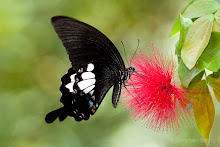completed my set of royals with the third species - the rare
Felder's Royal. It stayed in the treetops for a long period of time
before finally coming down to eye level when the sun became too
unbearable. It would be nice to say that my heart was thumping
almost audibly as I snatched this shot but I admit that that is a slight
exaggeration.
The Felder's Royal is a small butterfly, with a wingspan of only 35mm.
While it may appear drab on the underside, apart from the splash of
orange and blue at the hindwing tornus, the upperside is a brilliant
shining turquoise. Sadly, they land with their wings shut and the blue
can only be seen fully in flight. It has a habit of landing underneath leaves.
It was rediscovered in Singapore in 1999. So far, sightings have
mainly been from the Southern Ridges but I saw mine in the heart
of the Central Catchment area. Here is another record shot I got
when it landed some distance away from me.
Out of the three royals, the Felder's royal is rather rare. Last year
I was fortunate enough to observe the rarest of the trio, Tajuria
dominus, near my house. Recently I saw a female t.dominus
fluttering around a mistletoe high up in a tree (also outside my
house) - promising evidence that the species is still breeding and
surviving.























